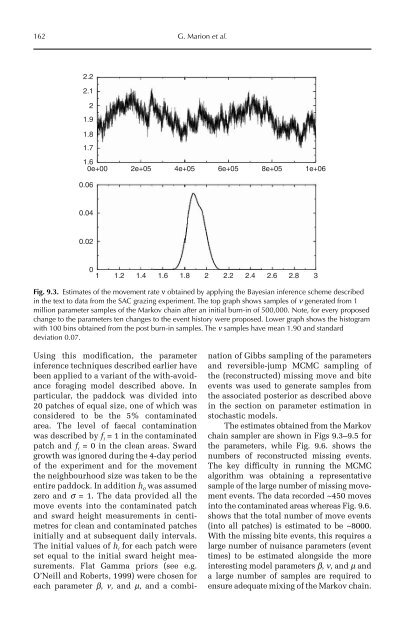Redesigning Animal Agriculture
Redesigning Animal Agriculture
Redesigning Animal Agriculture
Create successful ePaper yourself
Turn your PDF publications into a flip-book with our unique Google optimized e-Paper software.
162 G. Marion et al.<br />
2.2<br />
2.1<br />
2<br />
1.9<br />
1.8<br />
1.7<br />
1.6<br />
0e+00<br />
0.06<br />
0.04<br />
0.02<br />
0<br />
1<br />
Using this modification, the parameter<br />
inference techniques described earlier have<br />
been applied to a variant of the with-avoidance<br />
foraging model described above. In<br />
particular, the paddock was divided into<br />
20 patches of equal size, one of which was<br />
considered to be the 5% contaminated<br />
area. The level of faecal contamination<br />
was described by f i = 1 in the contaminated<br />
patch and f i = 0 in the clean areas. Sward<br />
growth was ignored during the 4-day period<br />
of the experiment and for the movement<br />
the neighbourhood size was taken to be the<br />
entire paddock. In addition h 0 was assumed<br />
zero and s = 1. The data provided all the<br />
move events into the contaminated patch<br />
and sward height measurements in centimetres<br />
for clean and contaminated patches<br />
initially and at subsequent daily intervals.<br />
The initial values of h i for each patch were<br />
set equal to the initial sward height measurements.<br />
Flat Gamma priors (see e.g.<br />
O’Neill and Roberts, 1999) were chosen for<br />
each parameter b, n, and m, and a combi-<br />
2e+05 4e+05 6e+05 8e+05 1e+06<br />
1.2 1.4 1.6 1.8 2 2.2 2.4 2.6 2.8 3<br />
Fig. 9.3. Estimates of the movement rate ν obtained by applying the Bayesian inference scheme described<br />
in the text to data from the SAC grazing experiment. The top graph shows samples of n generated from 1<br />
million parameter samples of the Markov chain after an initial burn-in of 500,000. Note, for every proposed<br />
change to the parameters ten changes to the event history were proposed. Lower graph shows the histogram<br />
with 100 bins obtained from the post burn-in samples. The n samples have mean 1.90 and standard<br />
deviation 0.07.<br />
nation of Gibbs sampling of the parameters<br />
and reversible-jump MCMC sampling of<br />
the (reconstructed) missing move and bite<br />
events was used to generate samples from<br />
the associated posterior as described above<br />
in the section on parameter estimation in<br />
stochastic models.<br />
The estimates obtained from the Markov<br />
chain sampler are shown in Figs 9.3–9.5 for<br />
the parameters, while Fig. 9.6. shows the<br />
numbers of reconstructed missing events.<br />
The key difficulty in running the MCMC<br />
algorithm was obtaining a representative<br />
sample of the large number of missing movement<br />
events. The data recorded ~450 moves<br />
into the contaminated areas whereas Fig. 9.6.<br />
shows that the total number of move events<br />
(into all patches) is estimated to be ~8000.<br />
With the missing bite events, this requires a<br />
large number of nuisance parameters (event<br />
times) to be estimated alongside the more<br />
interesting model parameters b, n, and m and<br />
a large number of samples are required to<br />
ensure adequate mixing of the Markov chain.










